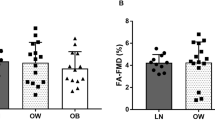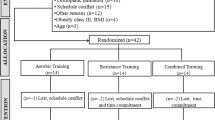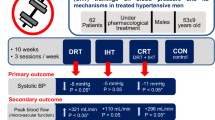Abstract
The vascular responses to acute resistance exercise and resistance exercise training (RET) in overweight women are unclear. Therefore, the purpose of this study was to examine the vasodilatory and wave reflection responses to acute resistance exercise before and after RET. In all, 24 overweight/obese (28.5±0.6 kg m−2) women (44±1 years of age) volunteered for this study. Forearm blood flow (FBF), vasodilatory capacity in response to reactive hyperemia (peak FBF) and wave reflection (radial tonometry) were measured, before and 15 min after five sets of leg press at 10-repetition maximum (RM). Measures of pulse wave reflection included the augmentation index (AIx) and the time of the reflected wave (Tr). Measurements were collected at baseline, after a 4-week control period (before RET) and after 12 weeks of whole-body RET using three sets of five exercises at 50–60% of 1-RM. There were no differences in vascular measurements at baseline or before RET for any variable. Resting FBF (66.7%) and peak FBF (51.6%) increased significantly (P<0.05) after RET compared with before RET. Post-exercise FBF (48.9%) and peak FBF (41.1%) also increased significantly (P<0.05) after RET compared with before RET. Post-exercise AIx decreased significantly (P<0.05), whereas Tr increased significantly (P<0.05) compared with rest at all time points. However, AIx and Tr were unaltered by RET. The 12-week whole-body RET increased the resting and post-exercise FBF as well as vasodilatory capacity without changing wave reflection in premenopausal overweight women. RET may be an important non-pharmacological therapy for reducing cardiovascular risk in overweight and obese premenopausal women.
This is a preview of subscription content, access via your institution
Access options
Subscribe to this journal
Receive 12 digital issues and online access to articles
$119.00 per year
only $9.92 per issue
Buy this article
- Purchase on Springer Link
- Instant access to full article PDF
Prices may be subject to local taxes which are calculated during checkout


Similar content being viewed by others
References
Moyna NM, Thompson PD . The effect of physical activity on endothelial function in man. Acta Physiol Scand 2004; 180 (2): 113–123.
Higashi Y, Yoshizumi M . New methods to evaluate endothelial function: method for assessing endothelial function in humans using a strain-gauge plethysmography: nitric oxide-dependent and -independent vasodilation. J Pharmacol Sci 2003; 93 (4): 399–404.
Sitia S, Tomasoni L, Atzeni F, Ambrosio G, Cordiano C, Catapano A et al. From endothelial dysfunction to atherosclerosis. Autoimmun Rev 2010; 9 (12): 830–834.
Lloyd-Jones D, Adams RJ, Brown TM, Carnethon M, Dai S, De Simone G et al. Executive Summary: heart disease and stroke statistics—2010 update: A report from the American Heart Association, Circulation 2010; 121 (7): 948–954.
Negrao CE, Trombetta IC, Batalha LT, Ribeiro MM, Rondon MU, Tinucci T et al. Muscle metaboreflex control is diminished in normotensive obese women. Am J Physiol Heart Circ Physiol 2001; 281 (2): H469–H475.
Van Guilder GP, Stauffer BL, Greiner JJ, Desouza CA . Impaired endothelium-dependent vasodilation in overweight and obese adult humans is not limited to muscarinic receptor agonists. Am J Physiol Heart Circ Physiol 2008; 294 (4): H1685–H1692.
Wykretowicz A, Adamska K, Guzik P, Krauze T, Wysocki H . Indices of vascular stiffness and wave reflection in relation to body mass index or body fat in healthy subjects. Clin Exp Pharmacol Physiol 2007; 34 (10): 1005–1009.
Kelly RP, Millasseau SC, Ritter JM, Chowienczyk PJ . Vasoactive drugs influence aortic augmentation index independently of pulse-wave velocity in healthy men. Hypertension 2001; 37 (6): 1429–1433.
Olson TP, Dengel DR, Leon AS, Schmitz KH . Moderate resistance training and vascular health in overweight women. Med Sci Sports Exerc 2006; 38 (9): 1558–1564.
Heffernan KS, Fahs CA, Iwamoto GA, Jae SY, Wilund KR, Woods JA et al. Resistance exercise training reduces central blood pressure and improves microvascular function in African American and white men. Atherosclerosis 2009; 207 (1): 220–226.
Collier SR, Kanaley JA, Carhart Jr R, Frechette V, Tobin MM, Hall AK et al. Effect of 4 weeks of aerobic or resistance exercise training on arterial stiffness, blood flow and blood pressure in pre- and stage-1 hypertensives. J Hum Hypertens 2008; 22 (10): 678–686.
Nichols WW, Epstein BJ . Actions of selected cardiovascular hormones on arterial stiffness and wave reflections. Curr Pharm Des 2009; 15 (3): 304–320.
Nichols WW, Singh BM . Augmentation index as a measure of peripheral vascular disease state. Curr Opin Cardiol 2002; 17 (5): 543–551.
Nichols WW . Clinical measurement of arterial stiffness obtained from noninvasive pressure waveforms. Am J Hypertens 2005; 18 (1 Part 2): 3S–10S.
Collier SR, Diggle MD, Heffernan KS, Kelly EE, Tobin MM, Fernhall B . Changes in arterial distensibility and flow-mediated dilation after acute resistance vs aerobic exercise. J Strength Cond Res 2010; 24 (10): 2846–2852.
Fahs CA, Heffernan KS, Fernhall B . Hemodynamic and vascular response to resistance exercise with L-arginine. Med Sci Sports Exerc 2009; 41 (4): 773–779.
Yoon ES, Jung SJ, Cheun SK, Oh YS, Kim SH, Jae SY . Effects of acute resistance exercise on arterial stiffness in young men. Korean Circ J 2010; 40 (1): 16–22.
Figueroa A, Vicil F . Post-exercise aortic hemodynamic responses to low-intensity resistance exercise with and without vascular occlusion. Scand J Med Sci Sports 2011; 21 (3): 431–436.
Arce Esquivel AA, Welsch MA . High and low volume resistance training and vascular function. Int J Sports Med 2007; 28 (3): 217–221.
Casey DP, Beck DT, Braith RW . Progressive resistance training without volume increases does not alter arterial stiffness and aortic wave reflection. Exp Biol Med (Maywood) 2007; 232 (9): 1228–1235.
Casey DP, Pierce GL, Howe KS, Mering MC, Braith RW . Effect of resistance training on arterial wave reflection and brachial artery reactivity in normotensive postmenopausal women. Eur J Appl Physiol 2007; 100 (4): 403–408.
Cortez-Cooper MY, DeVan AE, Anton MM, Farrar RP, Beckwith KA, Todd JS et al. Effects of high intensity resistance training on arterial stiffness and wave reflection in women. Am J Hypertens 2005; 18 (7): 930–934.
Taaffe DR, Galvao DA, Sharman JE, Coombes JS . Reduced central blood pressure in older adults following progressive resistance training. J Hum Hypertens 2007; 21 (1): 96–98.
O’Rourke MF, Pauca AL . Augmentation of the aortic and central arterial pressure waveform. Blood Press Monit 2004; 9 (4): 179–185.
Higashi Y, Sasaki S, Nakagawa K, Matsuura H, Kajiyama G, Oshima T . A noninvasive measurement of reactive hyperemia that can be used to assess resistance artery endothelial function in humans. Am J Cardiol 2001; 87 (1): 121–125.
Tagawa T, Imaizumi T, Endo T, Shiramoto M, Harasawa Y, Takeshita A . Role of nitric oxide in reactive hyperemia in human forearm vessels. Circulation 1994; 90 (5): 2285–2290.
Brzycki M . Strength testing—predicting a one-rep max from reps to fatigue. J Phys Educ Recreat Dance 1993; ; 64 (1): 88–90.
American College of Sports Medicine Position Stand. Progression models in resistance training for healthy adults. Med Sci Sports Exerc 2009; 41 (3): 687–708.
Limberg JK, De Vita MD, Blain GM, Schrage WG . Muscle blood flow responses to dynamic exercise in young obese humans. J Appl Physiol 2010; 108 (2): 349–355.
Jasperse JL, Seals DR, Callister R . Active forearm blood flow adjustments to handgrip exercise in young and older healthy men. J Physiol 1994; 474 (2): 353–360.
Collier SR, Kanaley JA, Carhart Jr R, Frechette V, Tobin MM, Bennett N et al. Cardiac autonomic function and baroreflex changes following 4 weeks of resistance versus aerobic training in individuals with pre-hypertension. Acta Physiol 2009; 195 (3): 339–348.
Endo T, Imaizumi T, Tagawa T, Shiramoto M, Ando S, Takeshita A . Role of nitric oxide in exercise-induced vasodilation of the forearm. Circulation 1994; 90 (6): 2886–2890.
Meredith IT, Currie KE, Anderson TJ, Roddy MA, Ganz P, Creager MA . Postischemic vasodilation in human forearm is dependent on endothelium-derived nitric oxide. Am J Physiol 1996; 270 (4 Part 2): H1435–H1440.
Campbell R, Fisher JP, Sharman JE, McDonnell BJ, Frenneaux MP . Contribution of nitric oxide to the blood pressure and arterial responses to exercise in humans. J Hum Hypertens 2011; 25 (4): 262–270.
Munir S, Jiang B, Guilcher A, Brett S, Redwood S, Marber M et al. Exercise reduces arterial pressure augmentation through vasodilation of muscular arteries in humans. Am J Physiol Heart Circ Physiol 2008; 294 (4): H1645–H1650.
Rakobowchuk M, McGowan CL, de Groot PC, Hartman JW, Phillips SM, MacDonald MJ . Endothelial function of young healthy males following whole body resistance training. J Appl Physiol 2005; 98 (6): 2185–2190.
Erdogan D, Caliskan M, Yildirim I, Gullu H, Baycan S, Ciftci O et al. Effects of normal blood pressure, prehypertension and hypertension on left ventricular diastolic function and aortic elastic properties. Blood Press 2007; 16 (2): 114–121.
Seals DR, Desouza CA, Donato AJ, Tanaka H . Habitual exercise and arterial aging. J Appl Physiol 2008; 105 (4): 1323–1332.
Matsui Y, Ishikawa J, Eguchi K, Hoshide S, Miyashita H, Shimada K et al. The influence of wave reflection on left ventricular hypertrophy in hypertensive patients is modified by age and gender. Hypertens Res 2008; 31 (4): 649–656.
Baynard T, Miller WC, Fernhall B . Effects of exercise on vasodilatory capacity in endurance- and resistance-trained men. Eur J Appl Physiol 2003; 89 (1): 69–73.
Copeland SR, Mills MC, Lerner JL, Crizer MF, Thompson CW, Sullivan JM . Hemodynamic effects of aerobic vs resistance exercise. J Hum Hypertens 1996; 10 (11): 747–753.
Ketel IJ, Stehouwer CD, Serne EH, Poel DM, Groot L, Kager C et al. Microvascular function has no menstrual-cycle-dependent variation in healthy ovulatory women. Microcirculation 2009; 16 (8): 714–724.
Adkisson EJ, Casey DP, Beck DT, Gurovich AN, Martin JS, Braith RW . Central, peripheral and resistance arterial reactivity: fluctuates during the phases of the menstrual cycle. Exp Biol Med 2010; 235 (1): 111–118.
Acknowledgements
This study was supported by a predoctoral American College of Sports Medicine Foundation Research Grant (FRG) from the American College of Sports Medicine Foundation. Additional funding came from the Florida State University Dissertation Grant and the College of Human Sciences Dissertation Grant.
Author information
Authors and Affiliations
Corresponding author
Ethics declarations
Competing interests
The authors declare no conflict of interest.
Rights and permissions
About this article
Cite this article
Kingsley, J., Figueroa, A. Effects of resistance exercise training on resting and post-exercise forearm blood flow and wave reflection in overweight and obese women. J Hum Hypertens 26, 684–690 (2012). https://doi.org/10.1038/jhh.2011.82
Received:
Revised:
Accepted:
Published:
Issue Date:
DOI: https://doi.org/10.1038/jhh.2011.82
Keywords
This article is cited by
-
Effects of aerobic, resistance and concurrent exercise on pulse wave reflection and autonomic modulation in men with elevated blood pressure
Scientific Reports (2021)
-
Impact of high- and low-intensity resistance training on arterial stiffness and blood pressure in adults across the lifespan: a review
Pflügers Archiv - European Journal of Physiology (2019)
-
Effects of age on arterial stiffness and central blood pressure after an acute bout of resistance exercise
European Journal of Applied Physiology (2016)
-
Effects of whole-body vibration exercise training on aortic wave reflection and muscle strength in postmenopausal women with prehypertension and hypertension
Journal of Human Hypertension (2014)
-
Resistance exercise training reduces arterial reservoir pressure in older adults with prehypertension and hypertension
Hypertension Research (2013)



